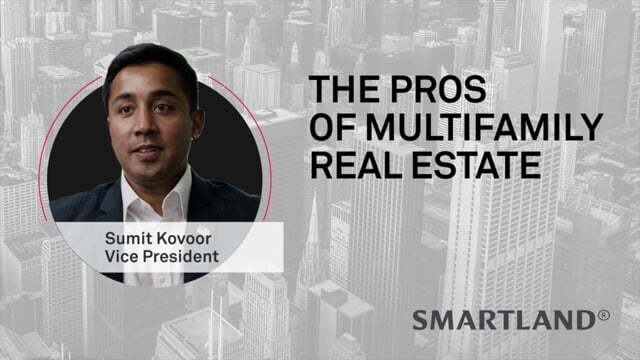Table of Contents
Introduction
One of the reasons so many people are attracted to real estate investing is its diversity. There are many different product types (office, retail, residential, industrial, etc.) and even further subsets within each of those segments. For example, residential can include single-family rentals, multifamily, student housing, senior housing and more.
In this article, we look at single family vs. multifamily investing. These are arguably two of the most popular ways to invest in real estate. Understanding the pros and cons of each is important before getting started.
What are Single-Family Rentals?
Single-family rentals (SFRs) are individual homes that are purchased by an individual who then rents the home to someone else. As we’ll discuss in more detail below, the low cost of most SFRs means there is a low barrier to entry. Someone who may not be able to afford a multifamily property may instead decide to invest in SFRs. Single family properties also require a lot of maintenance on a per-unit basis, which can be a drawback.
In recent years, purpose built SFR communities have become more common. These communities are called “built to rent” or BTR homes. There’s a big appetite for BTR communities, particularly among institutional investors looking to invest in a portfolio of properties.
What are Multifamily Rentals?
Multifamily rentals (MFRs) are properties with two or more rental units. Any property with four units or less will typically leverage residential financing. Any property with five or more units is considered “commercial property” and will be underwritten accordingly by lenders.
Single-family rentals (SFRs) are individual homes that are
purchased by an individuals, whereas Multifamily rentals (MFRs)
are properties with two or more rental units.
There are many benefits to owning MFRs, including the ability to have multiple income streams coming from the same property. Many first time investors will utilize an investing approach called “house hacking” in which they live in one unit and rent the others. This helps pay down the mortgage, lowering their own living expenses. It also provides early exposure to property management, which is arguably easier to do when living on site.
Multifamily property has historically been considered an alternative asset class. In recent years, commercial real estate investing has become more mainstream. Multifamily properties are now more competitive than ever.
What’re the Pros and Cons of Single-Family Investing?
 Relatively Affordable
Relatively Affordable
Single-family homes are usually more affordable, on the whole than multifamily properties. Lower costs are one of the things that lower the barrier to entry (more on this below). This makes single-family homes a great place for individuals to start on their real estate investing journeys.
Consider, for example, that most lenders will want investors to put down at least 20-25% equity when financing a rental property. On a $300,000 home, this equates to somewhere between $60,000 and $75,000. That cost is not insignificant. It is much less than a multifamily home that may cost closer to $1 million. Multifamily homes almost always have higher down payment requirements simply because they tend to be more costly.
 Low Barriers to Entry
Low Barriers to Entry
Single-family homes are more abundant and more affordable than multifamily properties. Depending upon the market there may be, for example, 500 single-family homes for every one multifamily property. The sheer volume of single-family homes makes it easier to purchase them as rentals. The supply of multifamily properties is more constrained. When one comes to market, competition is generally high.
Access to information also benefits SFR investments. Single-family home data is readily available using websites like Zillow and Redfin. This also lowers the barrier to entry for individual investors. Data on local comps helps investors make more informed decisions about whether to purchase an SFR and at what price. Data on multifamily properties tends to be sparser. In some areas, there may be no local multifamily sales to use as comps at all.
 Fewer Tenants to Manage
Fewer Tenants to Manage
In many ways, single-family rentals are easier to manage. The property is usually leased to just one individual or family. This cuts down on having to deal with multiple tenants, all of whom may have issues or concerns at all hours of the night. This is true only when someone has a small portfolio of SFRs. As their portfolio of SFRs increases, the number of tenants to manage also increases. This happens at a slower rate than if someone was investing in multifamily properties.
 Lower Vacancy and Long-Term Tenants
Lower Vacancy and Long-Term Tenants
Demand for SFRs is high and therefore, vacancy rates tend to be low. SFRs are attractive to renters of all types. This is especially true in suburban markets. In suburban markets people want to live in established neighborhoods with good schools, amenities, and low crime.
SFRs tend to attract long term tenants. People who rent SFRs tend to settle in and make the property their “home.” Those who live in apartment buildings may only do so for a year or two. They use the apartment as a “stopover” before landing somewhere else.
 Diverse Pool of Buyers / Greater Liquidity
Diverse Pool of Buyers / Greater Liquidity
One advantage to owning SFRs is that when it comes time to sell, there’s a robust pool of buyers. The buyers may include individuals looking to purchase for their own personal use. It may include investors. Or it may include people looking for a second home or vacation property. The widespread appeal of single-family homes helps investors preserve liquidity. It might take 6+ months to sell a multifamily property (depending on the market). Most single-family homes can be listed and sold in as little as 30-60 days.
 Higher Price Per Unit
Higher Price Per Unit
SFRs may be more affordable upfront. Investors will often end up paying more per unit than if they were investing in multifamily properties. For example, a single-family home might sell for $300,000 whereas a four-unit apartment building might sell for $1 million. Those who can afford the upfront costs associated with the multifamily will secure that property for $250,000 per door instead of $300,000. In some markets, the discrepancies between SFR and MFR price per door are even more dramatic.
 Hard to Manage and Maintain
Hard to Manage and Maintain
Managing one SFR is relatively straightforward. It becomes more complex after investing in multiple properties. This is especially true if the SFR investment properties are not located in close proximity. For example, an owner may need to show three SFRs to prospective tenants, and those three properties could be located in three different towns (or states!). This adds time and management complexity that is reduced by owning a multifamily property.
Along those same lines, SFRs can be difficult to maintain. Instead of mowing the lawn at one multifamily property, you now need to hire a landscaping crew for multiple properties. One way to mitigate this cost is to require the SFR renter to perform routine maintenance. That cost must be baked into the rent accordingly.
 Sole Source Income Stream
Sole Source Income Stream
Perhaps the greatest risk associated with owning SFR property is that these homes only have a single stream of income. If a tenant stops paying the rent, there is no other income to offset that cash flow disruption. The owner must continue paying the full costs associated with owning and operating the property. This includes the mortgage, taxes, insurance and routine repairs and maintenance.
In a worst case scenario, if an owner needs to evict the tenant, there could be 6+ months of rent that goes unpaid with no other income to offset those losses.
 Difficult to Scale
Difficult to Scale
SFRs are a great way for people to begin investing in rental property. However, scaling a portfolio of SFRs is rather difficult. While there are more SFRs available to purchase, each of these prospective investments requires its own due diligence. Buyers must become well versed in multiple neighborhoods. The actual closing process, with associated title and attorney fees, also ends up taking longer and being more expensive on a per unit basis than similarly scaled multifamily properties.
Managing a portfolio of SFRs is also challenging, as noted above. Each SFR has its own heating system to maintain, lawn to care for, roof to replace, etc. These costs can be averaged out across multiple units when investing in multifamily properties.
Interested in learning more? Watch these videos on the pros and cons of single-family real estate.


What’re the Pros and Cons of Multifamily Investing?
 Diversified Sources of Income
Diversified Sources of Income
One of the biggest benefits to owning multifamily property is the diversified income stream. Each unit pays its own separate rent. On the smaller end, this could equate to four rental payments per month at a 4 unit property. At a 250+ apartment building, there are that many more income streams to count on. This boosts overall cash flow (resulting in higher returns). It also mitigates the risk of nonpayment of rent.
In a SFR situation, if the tenant fails to pay rent, the owner incurs all costs of owning and operating the property in the meantime. This could be months. If someone stops paying their rent at a multifamily property, this is only a portion of the total cash flow. The owner can still leverage the other income streams to cover their costs and still generate profits.
 Economies of Scale
Economies of Scale
Multifamily properties also benefit from economies of scale. For example, you only need to have ONE closing for a multifamily property vs. a single closing for every individual SFR purchased. Depending on the size of the apartment building, it might warrant having a property manager or leasing office. The ability to bring those functions in house with multifamily properties helps to lower total costs. Lower costs result in greater profits that can be passed on to investors.
 Lower Costs Per Unit
Lower Costs Per Unit
The more units in a property, the lower the cost per unit to own, operate and maintain. For example, if the tax bill is $50,000 at a 50 unit apartment building, this is only $1,000 per unit. Few single-family homes will have a tax bill lower than that. The more units, the more each unit can contribute toward those costs (with costs per unit declining as number of units increases).
Multifamily offers tremendous cash flow and strong
return potential—so it should come as no surprise
that competition for these assets is fierce.
 Quantifiable Appreciation
Quantifiable Appreciation
Single family homes are valued based on local comps. Multifamily properties are valued on their revenue generating potential. This bodes well for investors who want to control their own destiny. They can “force” appreciation by making property improvements that increase net operating income (NOI) That NOI will be used to derive the value of the property.
 Easier to Scale
Easier to Scale
Someone who is looking to grow their real estate investment portfolio will find it is much easier to do so by investing in multifamily vs. SFRs. It could take years to aggregate a portfolio of 20 single-family homes. All it takes is one transaction to accomplish this with multifamily investments.
 Economically Resilient
Economically Resilient
Multifamily properties have historically performed well during all periods of an economic cycle. During an upswing, more people venture out on their own and rent their own apartments. They’re often willing to pay a premium to do so. During a downturn, many people are unfortunately forced to sell their homes (often at a loss) and then rent instead.
During periods of economic uncertainty, people who would have otherwise opted to buy decide to put their purchasing plans on hold and continue renting for longer. This makes multifamily an especially resilient asset class. It’s less prone to economic swings than SFR or other CRE product types.
 Higher Barriers to Entry
Higher Barriers to Entry
There are particularly high barriers to entry for multifamily investments, especially when compared to stocks, bonds, or even SFRs.
Let’s consider costs. As noted above, the costs associated with purchasing multifamily property can be high. This includes the time required to do due diligence (especially absent readily available data), down payment costs, closing costs and more. The sheer size of the down payment needed to buy most multifamily properties is a non starter for most individual investors.
 More Competition
More Competition
Multifamily offers tremendous cash flow and strong return potential. It should come as no surprise that competition for these assets is fierce. This is especially true as more institutional investors and family offices have entered the fray. It’s not uncommon for buyers to get into bidding wars. This turn drives up the price of the asset.
This puts pressure on investors to find off market deals that would otherwise fly under the radar. It’s also why the “best” deals often go to the most experienced teams; i.e., those who have the knowledge and experience to act quickly.
 Requires Management Experience
Requires Management Experience
Owning and operating a multifamily portfolio is not for the faint of heart. It takes significant experience to do it well. There are a lot of moving pieces, from accounting and marketing to property maintenance and asset management. Most multifamily investors will have a specific investment approach that requires discipline.
High demand has put pressure on overall returns. This makes it more important for investors to find ways to extract the most value at any given property. Those with significant multifamily experience are best positioned to maximize profitability on behalf of their investors.
Interested in learning more? Watch these videos on the pros and cons of multifamily real estate.


SFR vs. Multifamily: Which is Right for You?
As shown here, there are many differences between SFR and multifamily investments. Neither is inherently better or worse than the other. They’re just different. Determining which is best for you will depend on your goals, objectives, resources and experience. For example, someone who is investing for appreciation might consider SFRs. Those looking for cash flow (or some combination of appreciation and cash flow) will usually find that in multifamily deals.

Likewise, those looking to be more hands on with their investments might opt to begin investing in SFRs. Those who’d prefer to take a more passive approach should consider investing in multifamily. The latter lends itself to both direct ownership (a property owned individually but maintained by a property manager) as well as fractional ownership (i.e., investing alongside a qualified sponsor who manages the deal on behalf of limited partners).
Conclusion
At Smartland, we believe that multifamily is the best strategy for maximizing property value and creating wealth for our investment partners.
Multifamily properties have historically performed well during all periods of an economic cycle
Interested in learning more? Contact us today!
FAQs
What’s the basic difference between single-family and multifamily rentals?
Single-family rentals are individual homes leased to one household. Multifamily rentals have two or more units; 5+ units are typically underwritten as commercial property by lenders.
Why do many first time investors start with single-family?
Lower prices and abundant listings reduce the barrier to entry. There’s also widely available data for comps and pricing, which helps with due diligence.
What are the main pros and cons of single-family investing?
Pros: generally lower purchase price, easier to manage one tenant, often lower vacancy with longer term residents, and a broad buyer pool when selling. Cons: income depends on one tenant, higher price per unit, tougher to scale and maintain across scattered properties.
What are the main pros and cons of multifamily investing?
Pros: multiple income streams, economies of scale, lower costs per unit, the ability to “force” appreciation by improving NOI, and easier portfolio growth. Cons: higher down payments and acquisition costs, more competition, and heavier due diligence.
How are values determined differently?
Single-family values lean on local comparable sales. Multifamily values are driven by income, so improving operations and NOI can directly raise the property’s value.
Which is better for me?
Neither is universally “better.” If you prioritize affordability and a simpler first step, single-family can fit. If you want cash flow, scalability, and control over value via operations, multifamily often wins. Align the choice with your goals, resources, and experience.




